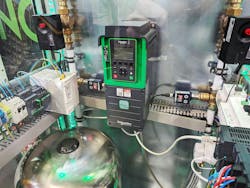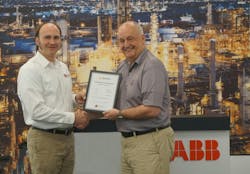Microgrids in Hawaii and Other News in Electrical, Renewable, and Efficiency Tech
Schneider Electric Receives Anybus Module Award
Schneider Electric, a leader in sustainable energy solutions, has received the 10,000,000th Anybus Module award from HMS Networks.
By integrating Anybus network connectivity interfaces into its line of variable speed drives, Schneider Electric provides its customers with a diverse range of drives that can be fine-tuned for performance and energy efficiency, enhancing operations and also contributing to a greener planet.
The award ceremony took place at the Schneider Electric headquarters in Paris. Present at the ceremony were Magnus Jansson, Product Marketing Director at HMS Networks, Jean-Louis Guillou, VP Drives at Schneider Electric, and Peter Greenfort, Strategic Account Manager at HMS Networks.
Schneider employs multifaceted strategies to promote a sustainable world. One key approach involves assisting customers in reducing energy consumption while maximizing the impact of the energy they use. Schneider Electric’s significant contributions to carbon emissions reduction are publicly disclosed every quarter.
Currently, 42% of the total avoided carbon emissions in the Schneider Electric carbon emission report can be attributed to Variable Speed Drives and the more efficient use of electrical motors, states Jean-Louis Guillou, VP Drives - Industrial Control & Drives.
He also observes that the trends in drives align with broader industry shifts. Intelligence is increasingly embedded in products, and with each new drive generation, processing power doubles—a deliberate effort to improve monitoring and control to further improve overall efficiency. To achieve optimal motor performance, continuous monitoring and adjustment are crucial. This necessitates smart automation equipment that can be intelligently controlled. In certain industries, up to 50% of total energy consumption is attributed to electrical motors. By employing smart drives to regulate these motors, energy consumption can be reduced by up to 20%, explains Jean-Louis Guillou.
Schneider Electric and HMS Networks have maintained a partnership for two decades. During this time, HMS Networks has been instrumental in developing network connectivity solutions for Schneider Electric's variable speed drives, enabling seamless connectivity to industrial control networks.
These networks span various protocols, including PROFINET, EtherNet/IP, EtherCAT, Modbus TCP, and more. The collaboration between Schneider and HMS Networks has been essential in achieving a solution for supporting multiple industrial communication protocols.
Watch the interview with Jean-Louis Guillou below.
Smoltek Obtains Patent for Capacitance Density
Smoltek Nanotech Holding AB has received a new patent that introduces an MIM-capacitor device that can double or triple the capacitance density of the company's CNF-MIM capacitors.
This patent is the first in a new patent family called Multilayer Cap and details an invention for a layered energy storage device, e.g. a capacitor, built using a metal-insulator-metal (MIM) configuration.
The invention relates to metal-insulator-metal (MIM) electrostatic and/or electrochemical energy storage devices, including capacitors and batteries. It introduces a method for creating a carbon nanofiber (CNF) based, multilayer MIM structure, where electrodes and dielectrics are layered. This approach of stacking conductor-insulator layers is developed to increase the capacitance density.
The patent application includes two independent claims: A device claim, which outlines the stacked multilayer capacitor structure having alternating conductor-insulator layers. And a method claim that details the fabrication process of such a device using conformal coating on the CNFs.
Smoltek develops process technology and concepts to solve advanced materials engineering problems in several industrial sectors. The company protects its unique carbon nanotechnology through an extensive patent portfolio, consisting of more than 110 applied for patents, of which 90 have been granted.
“For ABB, this certificate is an important milestone on our journey towards a fully digitalized instrumentation and network-centric architecture. Getting this certificate means we can be quick in rolling out APL technology to other instruments based on the same platform. More specifically, pressure and temperature instrumentation is expected in 2025," said Tilo Merlin, Platform Manager for Instrumentation and Head of APL Development Program, ABB Measurement & Analytics.
ABB Receives Ethernet-APL Certification for Flowmeters
FieldComm Group (FCG), based in Austin, Texas, has approved physical layer conformity of ABB's first vortex flowmeter (VortexMaster FSV400) and swirl flowmeter (SwirlMaster FSS400) with APL communication interfaces, following a series of tests.
Ethernet-APL (IEEE 802.3gc or 10Base-TL1) is a new member of the family of Ethernet standards, providing full Ethernet and TCP/IP connectivity in hazardous environments at 10Mbit/s for field instruments over fieldbus Type A cables, which are installed in many process plants around the world.
FieldComm Group and ABB are founding members of the APL project, working on technology development, standardization, and product testing and certification since 2015 along with other companies and organizations.
Product certification is a significant cornerstone for assuring superior product quality and interoperability in industrial communication networks”, said Paul Sereiko, director of marketing and product strategy at FCG.
Nordic Semiconductor Reaches Milestone in Greenhouse Gas Emission Reduction
Nordic Semiconductor, a provider of low-power wireless IoT connectivity solutions, has achieved its ambitious greenhouse gas (GHG) emission reduction targets. Validated by the Science Based Targets initiative (SBTi), SBTi commends Nordic Semiconductor's net-zero target by 2050, which is currently the most ambitious designation available through the SBTi process.
“Receiving validation from the SBTi is a significant achievement for Nordic Semiconductor,” says Ola Bostrøm, Senior Vice President of Quality, Nordic Semiconductor. “It confirms that our climate strategy and commitment to greenhouse gas emissions reduction are in line with the Paris Agreement's goal of limiting global warming to 1.5°C. The SBTi validated targets provide a clear, science-based path to what level we must reduce our greenhouse gas emissions in both our own operations, and in our value chain.”
Nordic Semiconductor commits to reduce its direct and indirect GHG emissions from energy usage ('Scope 1' and 'Scope 2') by 60% by 2030, with 2019 being its base year. Nordic will also reduce its emissions intensity (emission by value added) for other indirect emissions ('Scope 3').
Nordic aims to achieve this by reducing energy consumption and increasing renewable energy in its own operations.
In the longer-term, Nordic Semiconductor commits to a 2050 net-zero target, meaning any residual GHG emission in its value chain will be neutralized at that point in line with SBTi criteria.
Further detailed information on Nordic’s commitment to its SBTi and GHG emission reduction targets is included in the company’s latest Annual Report 2023.
Clean Energy Microgrids Come to Hawaii
Hover Energy, an international microgrid solutions provider, and Hawaii Construction & Development Consulting (HCDC), a Hawaii-based construction and development company with 20 years of experience in sustainable development, have announced a joint renewable energy project in Hawaii.
In conjunction with HCDC's renovation of Union Plaza in downtown Honolulu, Hover will install an onsite microgrid, which will include wind generators, solar panels, and a control system that will allow the site to generate all of its energy needs from renewable sources.
Microgrids are localized energy systems capable of operating independently or in conjunction with the electrical grid. They consist of distributed energy resources, such as solar panels, wind turbines, batteries, and generators, that produce, store, and manage electricity within a defined area. Hover is a microgrid developer with multi-patented, proprietary technologies.
HCDC has been advocating for the deployment of clean technologies in Hawaii for decades and is now designing microgrids for all new Hawaii projects. Ramping up clean energy production by adding a second generating source has always been in HCDC's plans. Alternus Clean Energy, Hover's Joint Venture partner, has agreed to finance the current pipeline of projects which consists of nearly a dozen projects across the state.
Hawaii holds a unique position that very few places on the planet can claim. First, wind and solar resources are abundant. Second, the state offers a renewable energy tax credit of 35%, to accompany existing federal tax credits offered in the Inflation Reduction Act of 2023. And third, the current cost of grid power is extremely high, offering very favorable returns to any power source that offsets those costs, which helps both investors and buyers develop renewable solutions such as Hover's Wind-Powered Microgrid.
About the Author
Laura Davis
Editor-in-Chief, New Equipment Digest
Laura Davis is the editor in chief of New Equipment Digest (NED), a brand part of the Manufacturing Group at EndeavorB2B. NED covers all products, equipment, solutions, and technology related to the broad scope of manufacturing, from mops and buckets to robots and automation. Laura has been a manufacturing product writer for eight years, knowledgeable about the ins and outs of the industry, along with what readers are looking for when wanting to learn about the latest products on the market.


